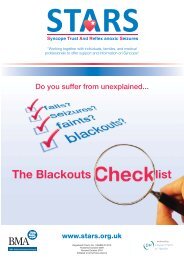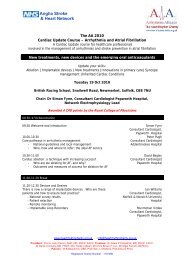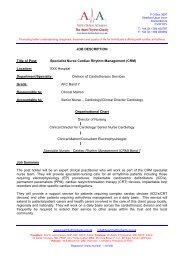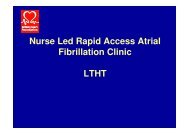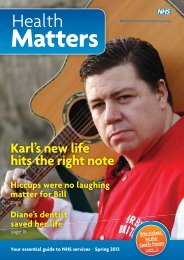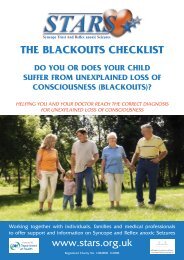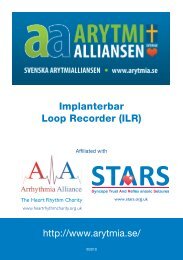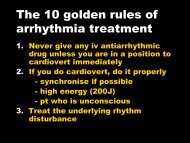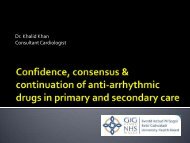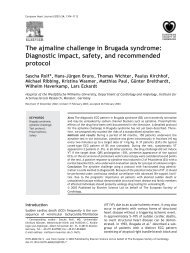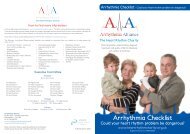Confidence, Consensus & Continuation of Anti- Arrhythmic Drugs in ...
Confidence, Consensus & Continuation of Anti- Arrhythmic Drugs in ...
Confidence, Consensus & Continuation of Anti- Arrhythmic Drugs in ...
Create successful ePaper yourself
Turn your PDF publications into a flip-book with our unique Google optimized e-Paper software.
<strong>Confidence</strong>, <strong>Consensus</strong><br />
& <strong>Cont<strong>in</strong>uation</strong> <strong>of</strong> <strong>Anti</strong>-<br />
<strong>Arrhythmic</strong> <strong>Drugs</strong> <strong>in</strong><br />
Primary and Secondary<br />
Care<br />
Dr Christopher Gibbs MD FRCP,<br />
Consultant Cardiologist,<br />
North Devon District Hospital<br />
April 2012
Objectives<br />
• Highlight strengths and weaknesses <strong>of</strong> the<br />
ma<strong>in</strong> anti-arrhythmic drugs<br />
• Outl<strong>in</strong>e appropriate patient style for each <strong>of</strong><br />
the anti-arrhythmic drugs<br />
• Outl<strong>in</strong>e the importance <strong>of</strong> monitor<strong>in</strong>g patients<br />
who are prescribed anti-arrhythmic drugs<br />
• Local/practical issues that may present with<br />
the use <strong>of</strong> anti-arrhythmic drugs
‘Natural History <strong>of</strong> Atrial Fibrillation (AF) and<br />
management Strategies Includ<strong>in</strong>g <strong>Anti</strong>arrhythmic<br />
<strong>Drugs</strong> (AAD’s)<br />
et al. Eur Heart J 2010;31:2369-2429<br />
© The European Society <strong>of</strong> Cardiology 2010. All rights reserved. For Permissions please email:<br />
journals.permissions@oxfordjournals.org.
ESC Guidel<strong>in</strong>es Recommend Comprehensive<br />
Management <strong>of</strong> AF<br />
Improve outcomes <strong>of</strong> AF "disease"<br />
Prevent AF<br />
recurrence<br />
Rhythm control<br />
Slow ventricular<br />
response<br />
Rate control<br />
Impact<br />
associated risks<br />
CV effects<br />
Treat AF "Arrhythmia"<br />
The ma<strong>in</strong> selected strategy could be either rhythm or rate control, or their comb<strong>in</strong>ation<br />
The other components optimise the treatment effect and contribute to improve outcomes<br />
Camm AJ, et al. Eur Heart J 2010;31:2369–2429
Pr<strong>in</strong>ciples <strong>of</strong> <strong>Anti</strong>arrhythmic Drug Therapy to<br />
Ma<strong>in</strong>ta<strong>in</strong> S<strong>in</strong>us Rhythm<br />
• Treatment is motivated by attempts to reduce AFrelated<br />
symptoms<br />
• Efficacy <strong>of</strong> antiarrhythmic drugs to ma<strong>in</strong>ta<strong>in</strong> s<strong>in</strong>us<br />
rhythm is modest<br />
• Cl<strong>in</strong>ically successful antiarrhythmic drug therapy may<br />
reduce rather than elim<strong>in</strong>ate the occurrence <strong>of</strong> AF<br />
Camm AJ, et al. Eur Heart J 2010;31:2369–2429
Pr<strong>in</strong>ciples <strong>of</strong> <strong>Anti</strong>arrhythmic Drug Therapy to<br />
Ma<strong>in</strong>ta<strong>in</strong> S<strong>in</strong>us Rhythm<br />
• If one antiarrhythmic drug ‘fails’, a cl<strong>in</strong>ically acceptable<br />
response may be achieved with another agent<br />
• Drug-<strong>in</strong>duced proarrythmia and extracardiac side<br />
effects are frequent<br />
• Safety rather than efficacy should primarily guide choice<br />
<strong>of</strong> antiarrhythmic agent<br />
Camm AJ, et al. Eur Heart J 2010;31:2369–2429
<strong>Anti</strong>arrhythmic Medication for<br />
Rhythm Control<br />
Recommendation Class Level<br />
The follow<strong>in</strong>g antiarrhythmic drugs are recommended for rhythm control <strong>in</strong> patients<br />
with AF, depend<strong>in</strong>g on underly<strong>in</strong>g heart disease:<br />
• amiodarone I A<br />
• dronedarone I A<br />
• fleca<strong>in</strong>ide I A<br />
• propafenone I A<br />
• d,l-sotalol I A<br />
In patients without significant structural heart disease, <strong>in</strong>itial antiarrhythmic therapy<br />
should be chosen from dronedarone, fleca<strong>in</strong>ide, propafenone, and sotalol<br />
If one antiarrhythmic drug fails to reduce the recurrence <strong>of</strong> AF to a cl<strong>in</strong>ically<br />
acceptable level, the use <strong>of</strong> another antiarrhythmic drug should be considered<br />
I<br />
IIa<br />
A<br />
C<br />
Camm AJ, et al. Eur Heart J 2010;31:2369–2429
Choice <strong>of</strong> <strong>Anti</strong>arrhythmic Drug Accord<strong>in</strong>g to<br />
Underly<strong>in</strong>g Pathology<br />
M<strong>in</strong>imal or no heart disease<br />
Significant underly<strong>in</strong>g heart disease<br />
Prevention <strong>of</strong> remodell<strong>in</strong>g<br />
ACEI/ARB/stat<strong>in</strong><br />
β blockade where appropriate<br />
Treatment <strong>of</strong> underly<strong>in</strong>g condition and prevention/reversal <strong>of</strong><br />
remodell<strong>in</strong>g – ACEI/ARB/stat<strong>in</strong>. β blockade where appropriate<br />
HT<br />
CAD<br />
CHF<br />
No LVH LVH Stable NYHA III/IV<br />
NYHA I/II or ‘unstable’<br />
NYHA II<br />
Dronedarone / Fleca<strong>in</strong>ide /<br />
Propafenone / Sotalol<br />
Dronedarone<br />
Dronedarone<br />
Sotalol<br />
Dronedarone<br />
Amiodarone<br />
Amiodarone<br />
Amiodarone<br />
NYHA = New York Heart Association<br />
‘Unstable’ = cardiac decompensation with<strong>in</strong> the prior 4 weeks<br />
= evidence for ‘upstream’ therapy for prevention <strong>of</strong> atrial remodell<strong>in</strong>g still rema<strong>in</strong>s controversial<br />
CAD: coronary artery disease; CHF: congestive heart failure<br />
HT: hypertension; LVH: left ventricular hypertrophy<br />
Adapted from: Camm AJ, et al. Eur Heart J 2010;31:2369–2429<br />
8
Mixed treatment comparison analysis: effect <strong>of</strong> antiarrhythmic<br />
drugs on atrial fibrillation recurrence.<br />
Freemantle N et al. Europace 2011;13:329-345<br />
Published on behalf <strong>of</strong> the European Society <strong>of</strong> Cardiology. All rights reserved. © The Author<br />
2011. For permissions please email: journals.permissions@oup.com.
Mixed treatment comparison analysis: effect <strong>of</strong> antiarrhythmic<br />
drugs on all-cause mortality.<br />
Freemantle N et al. Europace 2011;13:329-345<br />
Published on behalf <strong>of</strong> the European Society <strong>of</strong> Cardiology. All rights reserved. © The Author<br />
2011. For permissions please email: journals.permissions@oup.com.
Mixed treatment comparison analysis: effect <strong>of</strong> antiarrhythmic<br />
drugs on all-cause mortality <strong>in</strong> studies<br />
<strong>in</strong>volv<strong>in</strong>g >100 patients <strong>in</strong> either arm.<br />
Freemantle N et al. Europace 2011;13:329-345<br />
Published on behalf <strong>of</strong> the European Society <strong>of</strong> Cardiology. All rights reserved. © The Author<br />
2011. For permissions please email: journals.permissions@oup.com.
Mixed treatment comparison analysis: effect <strong>of</strong> antiarrhythmic<br />
drugs on withdrawal due to adverse events.<br />
Freemantle N et al. Europace 2011;13:329-345<br />
Published on behalf <strong>of</strong> the European Society <strong>of</strong> Cardiology. All rights reserved. © The Author<br />
2011. For permissions please email: journals.permissions@oup.com.
Amiodarone<br />
May cause severe extracardiac adverse events<br />
Associated with drug-<strong>in</strong>duced pro-arrhythmia<br />
Usually reserved for patients with frequent, symptomatic<br />
recurrences despite use <strong>of</strong> other antiarrhythmic drugs<br />
Can be used <strong>in</strong> patients with structural heart disease,<br />
<strong>in</strong>clud<strong>in</strong>g heart failure<br />
Recommendation Class Level<br />
Amiodarone is more effective <strong>in</strong> ma<strong>in</strong>ta<strong>in</strong><strong>in</strong>g s<strong>in</strong>us rhythm than sotalol, propafenone,<br />
fleca<strong>in</strong>ide (by analogy), or dronedarone (LOE A), but because <strong>of</strong> its toxicity pr<strong>of</strong>ile<br />
should generally be used when other agents have failed or are contra<strong>in</strong>dicated<br />
(LOE C)<br />
In patients with severe heart failure, NYHA class III and IV or recently unstable<br />
(decompensation with<strong>in</strong> the prior month) NYHA class II, amiodarone should be the<br />
drug <strong>of</strong> choice<br />
I<br />
I<br />
A<br />
B<br />
C<br />
Camm AJ, et al. Eur Heart J 2010;31:2369–2429<br />
13
Amiodarone: selected adverse reactions<br />
(far too many to list)<br />
• ARDS<br />
• Optic neuritis<br />
• Ataxia<br />
• Pancreatitis<br />
• AV block<br />
• Peripheral neuropathy<br />
• Bronchiolitis obliterans • Pneumonitis<br />
• Dyspnea<br />
• QT prolongation<br />
• Epididymitis<br />
• S<strong>in</strong>us bradycardia<br />
• Heart failure<br />
• Thrombocytopenia<br />
• Hepatitis<br />
• Torsade de po<strong>in</strong>tes<br />
• Hyper/hypothyroidism • Toxic epidermal necrolysis<br />
• Macular degeneration • Vasculitis
Amiodarone: adverse events<br />
• 15% <strong>of</strong> patients experience adverse events <strong>in</strong> the<br />
first year<br />
• 50% <strong>of</strong> patients report adverse effects with longterm<br />
use (photosensitivity <strong>in</strong> 25-75%)<br />
• 3.7-15% experience thyroid toxicity<br />
(particularly hypothyroidism)<br />
• 30% <strong>of</strong> patients may have abnormal LFT’s<br />
• 3% <strong>of</strong> patients may develop hepatitis<br />
• 90% corneal deposits, 5% optic neuropathy<br />
• 1-3% risk <strong>of</strong> pulmonary toxicity
Amiodarone: monitor<strong>in</strong>g<br />
Basel<strong>in</strong>e<br />
<strong>in</strong>vestigations<br />
To be undertaken by secondary care<br />
Chest X-ray (ensure CXR with<strong>in</strong> the last 12 months),<br />
TFT ( T 3 , T 4 & TSH) LFTs, urea & electrolytes and creat<strong>in</strong><strong>in</strong>e, ECG. Consideration<br />
could be given to lung function tests and exam<strong>in</strong>ation <strong>of</strong> sk<strong>in</strong>, eyes, and<br />
neurological systems<br />
Electrolyte<br />
Every 6 months <strong>in</strong><br />
patients tak<strong>in</strong>g<br />
diuretics<br />
Avoid hypokalaemia<br />
Correct the cause <strong>of</strong><br />
hypokalaemia<br />
Primary<br />
Care<br />
Eyes Annual Opthalmological exam<strong>in</strong>ation<br />
recommended <strong>in</strong> data sheet<br />
Patient should be encouraged<br />
to attend optician annually.<br />
Both<br />
If blurred or<br />
decreased vision<br />
Arrange urgent opthalmological<br />
assessment<br />
Discuss urgently with Specialist Both
Amiodarone: monitor<strong>in</strong>g<br />
Monitor<strong>in</strong>g Frequency Results Action &<br />
Responsibility<br />
Every 6 months*<br />
Cl<strong>in</strong>ical adverse effects<br />
Cl<strong>in</strong>ical<br />
effectiveness<br />
Every 6 months*<br />
Assess for adverse effects<br />
Assess patient rema<strong>in</strong>s <strong>in</strong> s<strong>in</strong>us rhythm and heart rate is<br />
satisfactory<br />
*Patient is assessed twice per year:<br />
Cl<strong>in</strong>ical GP assessment<br />
Alternates approximately 6 monthly with<br />
Cl<strong>in</strong>ical/ ECG assessment, secondary care unless otherwise stated.<br />
Both:<br />
Patients who<br />
have had<br />
lifethreaten<strong>in</strong>g<br />
arryhthmias<br />
TFT :<br />
T 3 ,T 4 &TSH<br />
(i)<br />
LFT<br />
Every 6 months >1.5 fold rise <strong>in</strong> AST or ALT,<br />
or signs <strong>of</strong> jaundice<br />
T 3 , T 4 & TSH<br />
If normal repeat<br />
every 6 months<br />
Normal<br />
TSH > 4.5 TSH > 4.5,<br />
fT 4 elevated and duration less than 3<br />
months<br />
Sub cl<strong>in</strong>ical<br />
hypothyroidism<br />
Hypothyroid TSH > 4.5,<br />
fT 4 low<br />
Thyrotoxicosis<br />
TSH > 10,<br />
fT 4 normal<br />
persist<strong>in</strong>g for over 6 months<br />
TSH < 0.1mU/l<br />
T 3 & T 4 normal<br />
or m<strong>in</strong>imally <strong>in</strong>creased<br />
TSH < 0.1mU/l<br />
& T 4 elevated,<br />
T 3 elevated or 50% greater than<br />
basel<strong>in</strong>e<br />
Discuss with specialist<br />
who may advise<br />
amiodarone withdrawal<br />
It is not unusual for<br />
patients on amiodarone to<br />
have slight elevations <strong>of</strong><br />
TSH and T 4<br />
Observe<br />
Repeat <strong>in</strong> 3 months<br />
Consider treat<strong>in</strong>g with<br />
levothyrox<strong>in</strong>e or repeat <strong>in</strong><br />
3 months<br />
May be treated with<br />
levothyrox<strong>in</strong>e if<br />
amiodarone is considered<br />
essential<br />
Repeat <strong>in</strong> 2-4 weeks<br />
Discuss urgently with<br />
specialist who may advise<br />
amiodarone withdrawal.<br />
Arrange TSH-receptor<br />
antibodies and TPO<br />
antibodies<br />
Primary Care
Sotalol: adverse events<br />
• Beta-blocker like effects (malaise, lethargy,<br />
wheeze, bradycardia)<br />
• QT prolongation and proarrhythmia (female, LVH,<br />
renal impairment)<br />
• Effects <strong>of</strong> QT prolongation potentially exacerbated<br />
by metabolic disturbance ( eg hypokalaemia) and<br />
medication (QT prolong<strong>in</strong>g medications,<br />
antipsychotics, citalopram)
Fleca<strong>in</strong>ide: adverse events<br />
• QT prolongation and proarrhythmia (NB coronary<br />
disease, impaired LV function)<br />
• Effects <strong>of</strong> QT prolongation potentially exacerbated<br />
by metabolic disturbance (eg hypokalaemia) and<br />
medication (QT prolong<strong>in</strong>g medications,<br />
antipsychotics, citalopram)<br />
• Beware atrial flutter (<strong>in</strong> the absence <strong>of</strong> betablockers<br />
or rate limit<strong>in</strong>g calcium antagonists) and<br />
AICD/pac<strong>in</strong>g thresholds...
Sotalol and Fleca<strong>in</strong>ide: Monitor<strong>in</strong>g<br />
BNF 58<br />
Sotalol: “with ECG monitor<strong>in</strong>g and measurement <strong>of</strong> corrected<br />
QT <strong>in</strong>terval”<br />
Fleca<strong>in</strong>ide: “<strong>in</strong>itiated under direction <strong>of</strong> hospital consultant”<br />
Summary <strong>of</strong> Product Characteristics: Sotalol: “caution if QTc on<br />
treatment >500, stop if >550”.<br />
ECG should be repeated after 2 weeks, ( 6 monthly) and after<br />
<strong>in</strong>creases <strong>in</strong> dose and advice taken if QTc >500 and stopped if<br />
QTc >550
Fleca<strong>in</strong>ide: use <strong>in</strong> the wrong population……….<br />
CAST: Cardiac Arrhythmia Suppression Trial<br />
All-cause mortality<br />
Survival<br />
(%)<br />
100<br />
95<br />
90<br />
85<br />
80<br />
Placebo (n=725)<br />
Enca<strong>in</strong>ide or fleca<strong>in</strong>ide (n=730)<br />
P=0.0003<br />
0 50 100 150 200 250 300 350 400 450 500<br />
Days after randomization<br />
CAST Investigators. N Engl J Med 1989; 321 :406 – 12.
Dronedarone: Updated Indications (October 2011)<br />
• Indicated <strong>in</strong> adult cl<strong>in</strong>ically stable patients with<br />
paroxysmal or persistent atrial fibrillation (AF)<br />
for the ma<strong>in</strong>tenance <strong>of</strong> s<strong>in</strong>us rhythm after<br />
successful cardioversion.<br />
• Should only be prescribed after alternative<br />
treatment options have been considered.<br />
• Treatment should only be <strong>in</strong>itiated and<br />
monitored by specialists to ensure that the<br />
benefit-risk balance is positive for patients.
Dronedarone: contra<strong>in</strong>dications<br />
As a result <strong>of</strong> the emergence <strong>of</strong> safety issues <strong>in</strong> the post<br />
market<strong>in</strong>g period (hepatic, lung, and the negative <strong>in</strong>otropic<br />
effect)<br />
Now contra<strong>in</strong>dicated <strong>in</strong> patients with:<br />
Unstable haemodynamic conditions<br />
History <strong>of</strong>, or current heart failure or left ventricular systolic<br />
dysfunction<br />
Permanent AF (AF duration ≥ 6 months or unknown, and<br />
attempts to restore s<strong>in</strong>us rhythm no longer considered by the<br />
physician)<br />
Liver and lung toxicity related to the previous use <strong>of</strong><br />
amiodarone
Dronedarone: Monitor<strong>in</strong>g<br />
Liver function is tested:<br />
‣ before <strong>in</strong>itiation <strong>of</strong> treatment and after one week<br />
‣ on a monthly basis for six months<br />
‣ at months 9 and 12 and then<br />
‣ periodically thereafter<br />
If alan<strong>in</strong>e transam<strong>in</strong>ase (ALT) levels are elevated ≥3 (upper limit <strong>of</strong> normal levels), then<br />
the levels should be re-measured with<strong>in</strong> 48-72 hours.<br />
If ALT levels are confirmed to be ≥3 (upper limit <strong>of</strong> normal levels), after reassessment,<br />
dronedarone treatment should be withdrawn.<br />
Other monitor<strong>in</strong>g requirements <strong>in</strong>cludes:<br />
‣ Regular cardiac exam<strong>in</strong>ations <strong>in</strong>clud<strong>in</strong>g an ECG at least every 6 months<br />
‣ INR closely monitored after <strong>in</strong>itiat<strong>in</strong>g dronedarone <strong>in</strong> patients tak<strong>in</strong>g vitam<strong>in</strong> K<br />
antagonists<br />
‣ Plasma digox<strong>in</strong> concentration, cl<strong>in</strong>ical and ECG monitor<strong>in</strong>g if patient on digox<strong>in</strong><br />
‣ Renal monitor<strong>in</strong>g with plasma creat<strong>in</strong><strong>in</strong>e values measured prior to and 7 days after<br />
<strong>in</strong>itiation <strong>of</strong> dronedarone<br />
‣ Pulmonary monitor<strong>in</strong>g as onset <strong>of</strong> dyspnoea or non productive cough may be related<br />
to pulmonary toxicity<br />
‣ Grapefruit juice should not be taken with dronedarone.<br />
‣ Co–adm<strong>in</strong>istration with potent cytochrome P 450 (CYP) 3A4 <strong>in</strong>hibitors is<br />
contra<strong>in</strong>dicated e.g. ketoconazole, itraconazole, posaconazole and clarithromyc<strong>in</strong>.
Cont<strong>in</strong>u<strong>in</strong>g antiarrhythmic drugs –<br />
the smooth transition
The Evidence: is Amiodarone therapy<br />
monitored appropriately longer-term<br />
• Review/audit <strong>of</strong> prescrib<strong>in</strong>g and monitor<strong>in</strong>g <strong>of</strong> 500 patients who had been<br />
prescribed amiodarone – Wrexham and Fl<strong>in</strong>tshire<br />
• 350, <strong>in</strong> retrospect, should not have been prescribed amiodarone<br />
• Mean age 76 years (average duration <strong>of</strong> therapy 5.5 years)<br />
• 70% <strong>in</strong>itiated <strong>in</strong> Secondary Care<br />
• 29% <strong>of</strong> cases documented <strong>in</strong>formation given regard<strong>in</strong>g monitor<strong>in</strong>g <strong>of</strong> noncardiac<br />
side effects<br />
• 28% monitored TFT’s and 29% LFT’s<br />
• 5% monitored for pulmonary complications<br />
• 2% monitored for opthalmic complications<br />
• 14% documented evidence <strong>of</strong> advice/counsell<strong>in</strong>g given to patient re:<br />
potential side effects <strong>of</strong> amiodarone<br />
Khan K, Rivl<strong>in</strong> G. Cardiology News<br />
2011 14 (2)
PROTOCOL:<br />
AMIODARONE<br />
This document should be read <strong>in</strong> conjunction with the current Summary <strong>of</strong> Product Characteristics<br />
http://www.medic<strong>in</strong>es.org.uk/<br />
1. Licensed<br />
Amiodarone is licensed for the treatment <strong>of</strong> severe cardiac rhythm disorders where other<br />
Indications<br />
treatments either cannot be used or have failed.<br />
The All Wales Medic<strong>in</strong>es Strategy Group recommends that shared care arrangements are<br />
2.<br />
suitable for patients newly <strong>in</strong>itiated on amiodarone. This protocol has been endorsed by the<br />
Therapeutic use & Welsh Cardiovascular Society (for patients with life-threaten<strong>in</strong>g arrythmias) and the Wales<br />
Background<br />
Council <strong>of</strong> the British Geriatric Society. The consultation process has <strong>in</strong>cluded Local Medical<br />
Committees and Welsh <strong>Drugs</strong> & Therapeutics Committees. This protocol does not cover the<br />
use <strong>of</strong> oral amiodarone <strong>in</strong> short term treatment prior to cardioversion. Amiodarone is<br />
commonly used to ma<strong>in</strong>ta<strong>in</strong> s<strong>in</strong>us rhythm <strong>in</strong> patients with atrial fibrillation or who have<br />
converted from, or relapsed <strong>in</strong>to atrial fibrillation follow<strong>in</strong>g cardioversion. It is also used before<br />
heart surgery to help prevent atrial fibrillation. Amiodarone has been used for prevention <strong>of</strong><br />
ventricular arrhythmias.<br />
Hypersensitivity to iod<strong>in</strong>e or amiodarone or any excipients, evidence or history <strong>of</strong><br />
3. Contra<strong>in</strong>dications hyperthyroidism, uncorrected hypothyroidism, s<strong>in</strong>us bradycardia and s<strong>in</strong>o-atrial heart block,<br />
comb<strong>in</strong>ed use with drugs that may <strong>in</strong>duce torsades de po<strong>in</strong>tes (see Drug Interactions below),<br />
pregnancy (except <strong>in</strong> exceptional circumstances) & breast feed<strong>in</strong>g. In patients with severe<br />
conduction disturbances or s<strong>in</strong>us node disease, amiodarone should be used only <strong>in</strong><br />
conjunction with a pacemaker.<br />
A load<strong>in</strong>g regimen is necessary and will be prescribed by secondary care.<br />
4. Typical Dosage<br />
Regimen (Adults) Load<strong>in</strong>g: 200mg three times daily for one week, then 200mg twice daily for one week, then a<br />
further reduction to 200mg daily.<br />
Ma<strong>in</strong>tenance dose is usually 200mg daily; however 100mg daily may be sufficient <strong>in</strong> elderly<br />
patients. The m<strong>in</strong>imum dose to control arrhythmia is used. In rare cases a ma<strong>in</strong>tenance dose<br />
<strong>of</strong> above 200mg daily may be required.<br />
All dose adjustments will be done by secondary care unless directions have been specified <strong>in</strong><br />
the medical letter to the GP.<br />
5. Drug Interactions<br />
For a<br />
comprehensive list<br />
consult the<br />
BNF(Appendix 1) or<br />
Summary <strong>of</strong> Product<br />
Characteristics<br />
Amiodarone is metabolised by the cytochrome P450 system and therefore has the potential to<br />
cause many drug <strong>in</strong>teractions. The Summary <strong>of</strong> Product Characteristics or BNF (Appendix 1)<br />
should be consulted before <strong>in</strong>itiat<strong>in</strong>g any new drug therapy.<br />
Amiodarone has an average plasma half life <strong>of</strong> 50 days (range 20-100 days). There is<br />
potential for drug <strong>in</strong>teractions to occur several weeks or months after stopp<strong>in</strong>g treatment and<br />
the onset <strong>of</strong> drug <strong>in</strong>teractions may be slow after <strong>in</strong>itiat<strong>in</strong>g amiodarone.<br />
Stat<strong>in</strong>s: Increased risk <strong>of</strong> myopathy. Simvastat<strong>in</strong>- restrict dose to 20mg daily.<br />
Other stat<strong>in</strong>s: counsel patients to report any muscle pa<strong>in</strong> or weakness immediately.<br />
<strong>Anti</strong>coagulants: Amiodarone can <strong>in</strong>crease anticoagulant effect. Consider warfar<strong>in</strong> dose<br />
reduction. Patients should be monitored closely and the dose <strong>of</strong> anticoagulant altered<br />
accord<strong>in</strong>gly, remember<strong>in</strong>g that amiodarone levels take several weeks to stabilise.<br />
<strong>Anti</strong>epileptics: Amiodarone can <strong>in</strong>crease plasma concentration <strong>of</strong> phenyto<strong>in</strong>, phenyto<strong>in</strong> dose<br />
should be reduced. Note that small changes <strong>in</strong> phenyto<strong>in</strong> dose can result <strong>in</strong> large changes <strong>in</strong><br />
phenyto<strong>in</strong> levels. Monitor patient closely and counsel on signs <strong>of</strong> toxicity.<br />
Beta blockers, <strong>in</strong>creased risk <strong>of</strong> bradycardia, AV block and myocardial depression.<br />
Sotalol-avoid concomitant use.<br />
Calcium channel blockers (diltiazem and verapamil): <strong>in</strong>creased risk <strong>of</strong> bradycardia, AV block<br />
and myocardial depression.<br />
Ciclospor<strong>in</strong>: Amiodarone <strong>in</strong>creases levels <strong>of</strong> ciclospor<strong>in</strong>. Reduced dose <strong>of</strong> ciclospor<strong>in</strong> is<br />
recommended.<br />
Digox<strong>in</strong> dose should be halved when amiodarone is started.<br />
Diuretics <strong>in</strong>creased risk <strong>of</strong> cardiotoxicity if hypokalaemia occurs<br />
<strong>Drugs</strong> that prolong the QT <strong>in</strong>terval: Concurrent therapy is contra-<strong>in</strong>dicated due to the<br />
<strong>in</strong>creased risk <strong>of</strong> torsades de po<strong>in</strong>tes,<br />
<strong>Anti</strong>arrhythmics: e.g. qu<strong>in</strong>id<strong>in</strong>e, proca<strong>in</strong>amide, disopyramide, sotalol.<br />
<strong>Anti</strong>psychotics: e.g. phenothiaz<strong>in</strong>es, haloperidol, amisulpiride.<br />
<strong>Anti</strong>histam<strong>in</strong>es: e.g. mizolast<strong>in</strong>e and terfenad<strong>in</strong>e.<br />
<strong>Anti</strong>malarials: e.g. chloroqu<strong>in</strong>e, hydroxychloroqu<strong>in</strong>e, mefloqu<strong>in</strong>e, qu<strong>in</strong><strong>in</strong>e<br />
Lithium and tricyclic antidepressants.<br />
Others: co-trimoxazole IV erythromyc<strong>in</strong>, moxifloxac<strong>in</strong>, pentamid<strong>in</strong>e, some antivirals
AAD’s - Key Po<strong>in</strong>ts<br />
• Treatment is motivated by attempts to reduce AF-related symptoms<br />
• Manage expectations - cl<strong>in</strong>ically successful antiarrhythmic drug therapy<br />
may reduce rather than elim<strong>in</strong>ate the occurrence <strong>of</strong> AF<br />
• Drug-<strong>in</strong>duced proarrythmia and extracardiac side effects are frequent<br />
• Safety rather than efficacy should primarily guide choice <strong>of</strong> antiarrhythmic<br />
agent<br />
• Informed patient discussion and <strong>in</strong>formation/literature for f<strong>in</strong>al decision<br />
(<strong>in</strong>clud<strong>in</strong>g copied correspondence)<br />
• Recommend<strong>in</strong>g cl<strong>in</strong>ician has responsibility for document<strong>in</strong>g strategy for<br />
monitor<strong>in</strong>g<br />
• Audit supports development <strong>of</strong> local Shared Care Pathways to improve<br />
monitor<strong>in</strong>g<br />
• Easy access for advice, support and specialist review for Primary care team<br />
and patients
Questions



